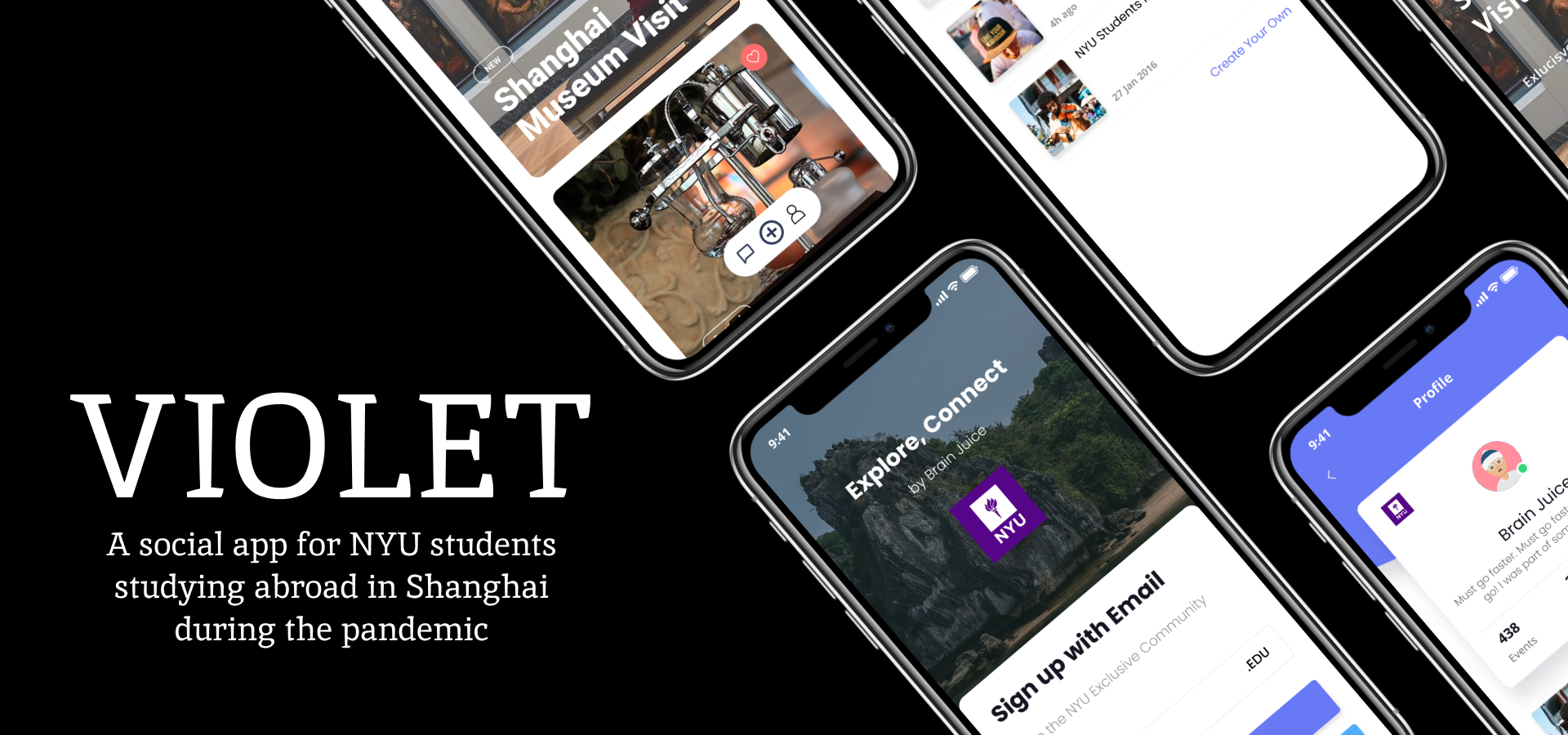
2 months, 2021
Duration
Yoki Xue
Huaze Shao
Yulong He
Sui Li Chan
Team Members
Figma, FigJam, Miro
Tools
Design Thinking
Rapid Prototyping
Wireflows
Guerilla Testing
Skills
Violet is a social application created for students of New York University that were affected by the pandemic. This platform aims to bridge the NYU Shanghai community with the NYU New York community.
Background
Kickoff
As of March 2020, many U.S universities were structurally challenged due to the pandemic. NYU New York Campus adapted by physically halting classes, increasing digitalization, and also pushing forward a program called “Go Local” which enables all NYU students to spend their semester in person at the nearest NYU Global Site.
Living in Hong Kong and as an NYU New York Student, I had the opportunity to go to the NYU Shanghai Campus.
Assumptions
As Go Local Students at NYU Shanghai ourselves, my group and I shared similar thoughts about the program and how certain expectations were not met. One aspect of the program we were strongly unsatisfied with was the social aspect. After several rounds of discussion, we collectively synthesized our thoughts into four main assumptions that served as a foundation to push our project forward.
Go Local Students deem that social life is important and can improve their academic experiences indirectly
Go Local Students don’t have enough information about the social activities that are happening
Go local students are not well connected among themselves
Go local students have little knowledge about Shanghai and would like to know more
Problems Identified
Understanding that dissatisfaction comes with its roots of desire and demand, we wanted to identify the needs of the majority.
Our assumptions led us to believe that:
majority of NYU Go Local Students need more quantities of social interactions,
non-native Shanghai Go Local students need more sources to know and explore interesting places in Shanghai.
Research & Analysis
In this section, we will confirm our assumptions by conducting five rounds of interviews with random Go Local Students. This will help us narrow our focus and create a better design framework.
User Research
To further confirm our assumptions on Go Local Students’ social life experiences, we conducted interviews with 5 random Go Local Students.
User Journey Map
Solving the Problem
Conducting the interviews has brought the problem to a better light. After synthesizing and analyzing the data from the interview, we had a better understanding of Go Local Students’ social experiences. Our next step was to ideate solutions that could potentially improve their experiences.
How Might We…
Chosen Solution
Amongst 20 solutions, we voted for the idea of a social app dedicated for Go Local Students.
This is a phone app that functions to compile all the existing events that are happening. Students can find the upcoming events or the events that they are going to attend on the home page. There is also a ‘message’ feature to communicate with other students. If students are interested, they can create their own events.
Prototyping & Testing
Our prototyping and usability testing were conducted in the same session. We were given 30 minutes to an hour to work on the prototype as much as possible. After prototyping, we conducted two rounds of usability tests (guerilla testing) and collected feedback from the participants.
Reframed (High Fidelity)
Based on the original illustration, our team used Figma (an interface design tool) to create a high-fidelity clickable prototype.
We iterated the design so that there are more frames to facilitate navigation (i.e. chat box icon will redirect users to a chat page and clicking on an event on the home page will redirect users to a page with more detailed information).
Main Features of Prototype I
Prototyping Process
After prototyping our product, we conducted two rounds of guerilla testing. We first invited participants to look through and interact with the interface for a few minutes, after which we asked them questions and collected feedback. We were happy to know that users were able to identify the purpose of the app. What was even more important was the pains and frustrations that they shared about certain features.
There were defects that we were not aware of while designing. For example, users are worried about what to do if they get bailed on by people who have signed up, what if they only want to see art events but there was no filter or category features, or what if someone they do not like signs up for the event?
Guerilla Testing & Feedback
After conducting our user test and reflection, we had a clearer idea of what we needed to improve on. We started iterating our prototype by adding more frames and interactions. We mapped out the user flow, hand-sketched the frames, and created a hi-fi prototype. Our prototyping and usability testing were conducted in the same session. We were given 30 minutes to an hour to work on the prototype as much as possible. After prototyping, we conducted two rounds of usability tests (guerilla testing) and collected feedback from the participants.
Iterations
Mapping User Flow
Lofi Sketches
Hi-Fi Prototype (Wireflow)
After adding more interactions, navigation, and screens, my group and I have developed a final prototype that can potentially improve the social experience within NYU community.